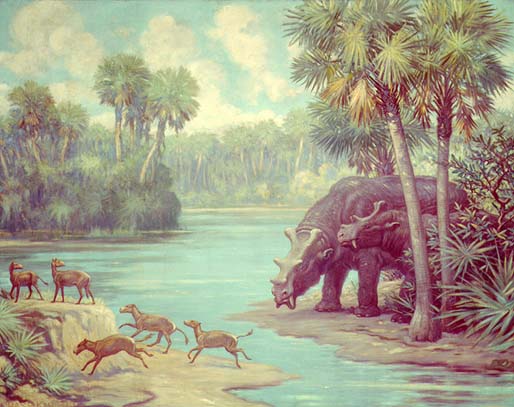As many of you know, I left Eugene on Saturday on a 3-week trip to Cincinnati and points between. The main purpose of my trip is to attend (and present at) the North American Paleontological Convention, but I'll be doing dissertation research at points along the way. This old blog has run fallow of late, so I thought that posting about my various stops along the way would be a good way of clearing out the cobwebs (you see, I'm so out of shape writing-wise that I'm using mixed metaphors; dear me...). I'll also be posting photos here. So, stay tuned: it should be an interesting ride.
I'm writing this from my first waypoint, Laramie, Wyoming (more about it in a later post), home of the University of Wyoming's vertebrate fossil collection (more about that later on, too). The drive here was one of the longest I'll be doing this entire trip, and it's a real shame I only had two days to do it. It's also a shame that the Mountain West has been experiencing one of its more protracted periods of thunderstorms in some time. Of course, I'm sure many of you are probably pretty jealous of this, but I was never much of a storm-chaser. To be sure, there is something breathtaking about seeing an impossibly dark cloud looming above the Rocky Mountains and to see the flashes of thunderbolts crashing all around you. Usually, I'm all for experiencing nature at its most sublime (a word that, as always, I use in its original sense, not the watered down version that's bandied about so much these days), and I think it's healthy to be reminded of just how small and insignificant you are from time to time. Thunderstorms, though, tend to impress me more with terror than with awe (other members of the Hopkins Lab will vouch for just how nervous I got when storm clouds hove into view during field work last summer). To me there is just something fundamentally wrong about a weather system that can simultaneously start flash floods and fire. Give me good, old-fashioned grey skies and a persistent drizzle any day.

That whining aside, there is one more thing worth mentioning briefly about my drive to Laramie. On several previous road trips, I've passed near Promontory, Utah, but had never stopped (part of the reason for this is that no one in my family has ever been too keen on spending money in the Beehive State for fear that a good chunk of any taxes you pay here will find their way to the Mormons). Still, as one of those kids who grew up loving all things train-related, Promontory has always had a strong attraction. As I'm sure everyone remembers from their history books, that was where Leland Stanford drove in the "Golden Spike" in 1869, joining his Southern Pacific Railroad to the Union Pacific and creating the first transcontinental railroad line. It's hard to overstate the importance of this event in the history of Westward Expansion: it pretty effectively marks the end of the age of mountain men and emigrant trails and the beginning what people tend to think of as the Wild West. As both a train and Western history buff, the allure proved just too much to ignore this time. I was a little disappointed to learn that the spike itself is back in California, and I also happened to arrive at a time of day during which there were no programs going on, so I'll confess the overall effect was a little underwhelming. Still, if you like your old steam locomotives, the park has two spectacularly restored examples (which I'm told they run a few times each day, sadly none of which was anywhere near the time I was around) and it's always worth seeing the spot where such an epochal event took place. It also gives you a chance to see some of the bird life that shows up this time of year at the north end of the Great Salt Lake (which, incidentally, manages to break several laws of physics by somehow being flatter than other bodies of water).
The thunderstorm-ridden drive across southern was unremarkable, but by way of a segue to my next post, I'd just like to briefly mention that it crosses the Bridger Basin. That name most likely doesn't ring a bell, but it would if you were a paleontologist. One of the great joys of traveling through this part of the country as a paleontologist is that you are continually encountering place names that are very familiar to you and your colleagues, to locals, and to absolutely no one else anywhere in the world. I imagine that if you study the Eocene, going to southeast Wyoming - and in particular, passing through Fort Bridger and Green River - must feel like coming home. Given that I've rambled on longer than I intended too already, I won't go into much detail on the historical and scientific significance of the Eocene beds of the Bridger Basin, but suffice it to say that they account for much of what we know about life on Earth between about 75 and 40 million years ago, and that many of the biggest names in paleontology have worked there. The same could be said for the Jurassic beds to the east or the Miocene beds near the Nebraska border. In short, there are few places on Earth as fossiliferous as Wyoming, a fact that you would think would make anyone proud. Turns out, though, that now is not a great time to be a paleontologist in the Equality State.

No comments:
Post a Comment